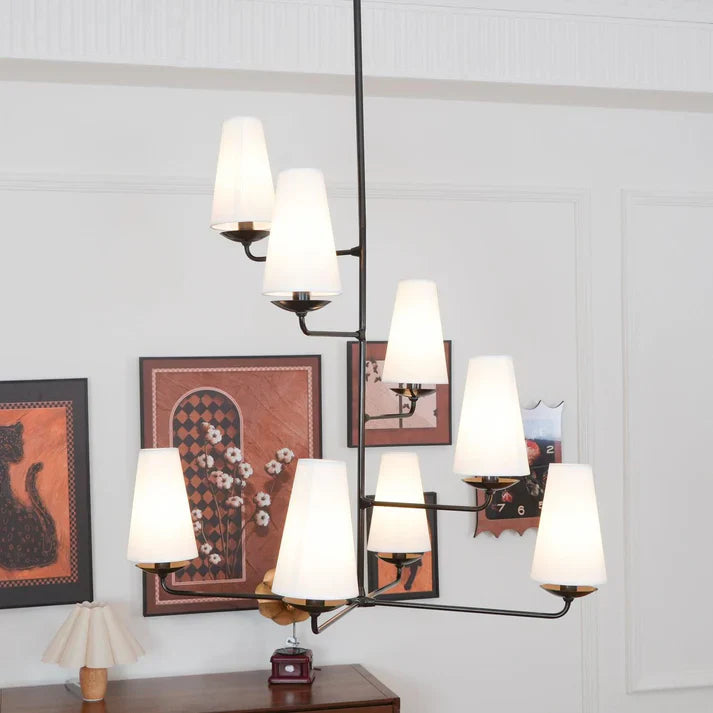
Vertical Chandelier — A Practical Guide to Style, Placement, and Care
A vertical chandelier is an elegant lighting solution that draws the eye up — literally. Unlike traditional horizontal chandeliers that spread out over a tabletop, vertical chandeliers stack light sources in a column or tier, creating dramatic height, depth, and a modern silhouette. If you’re looking to make a statement without overpowering a room, a vertical chandelier might be the perfect choice.

What exactly is a vertical chandelier?
A vertical chandelier arranges lights vertically rather than horizontally. That can mean multiple pendants hung along a single stem, stacked tiers of bulbs, or a sculptural column of light. Materials range from crystal and glass to metal and wood, so the look can be ultra-modern, industrial, glam, or transitional. The key feature is verticality — the fixture emphasizes height and creates a visual line from ceiling to floor.
Why choose a vertical chandelier?
-
Maximizes height: Great for rooms with high or vaulted ceilings where a horizontal fixture would look small or sparse.
-
Creates visual drama: The vertical line becomes an architectural feature, especially over stairwells, entryways, and two-story foyers.
-
Good for narrow spaces: A vertical chandelier works in long, narrow areas (hallways, banquettes) where width is limited but height is available.
-
Flexible scale: You can choose a slim, minimalist column for subtlety or a large multi-tiered piece for a bold focal point.
Best places to use one
-
Foyers and entryways: A vertical chandelier sets the tone when guests walk in.
-
Over staircases: It visually connects floors and moves light through the vertical plane.
-
Dining areas with high ceilings: Suspended above a long table, it adds intimacy without spreading horizontally.
-
Living rooms with tall ceilings: Pair with a seating arrangement below to anchor the space.
-
Kitchen islands in open-plan homes: In very tall ceilings, a vertical cluster can look intentional and contemporary.
How to choose the right vertical chandelier
-
Scale with room height: Measure ceiling height and account for distance from floor. For two-story foyers, fixtures that are 3–6 feet long are common; for standard 9–10 foot ceilings, choose shorter vertical fixtures or multi-light pendants.
-
Consider visual weight: Transparent glass or open metal frames read lighter in size than solid, opaque forms. If you want drama without heaviness, pick glass, crystals, or thin metal rods.
-
Match the style: Industrial metal and exposed bulbs suit lofts; crystal and faceted glass work for glam interiors; wood or matte metal complements Scandinavian or mid-century modern sites.
-
Lighting needs: Decide between ambient (general), task, or accent light. Many vertical chandeliers use multiple small bulbs — perfect for ambient light when paired with dimmers.
-
Dimming and bulb type: Choose dimmable LED bulbs for efficiency and mood control. Confirm fixture compatibility with dimmers before buying.
Installation & height guidelines (practical tips)
-
Entryways & foyers: The bottom of the chandelier should hang at least 7–8 feet above the floor in an entryway. For two-story foyos, let it occupy the vertical center.
-
Over dining tables: Keep the bottom 30–36 inches above the tabletop for standard 30-inch-tall tables. For taller ceilings, raise proportionally.
-
Over staircases: Position it so the lowest part clears head height along the stair path; allow visual centering from both floors if possible.
-
Wiring & mounting: Vertical chandeliers can be heavy or awkward to install; always use a ceiling box rated for the fixture’s weight and consider professional installation for safety and proper suspension.
Styling ideas
-
Clustered pendants: Group several slim pendants at staggered heights for a contemporary look.
-
Single vertical column: A long, linear fixture with stacked glass elements gives a sculptural feel.
-
Mixed materials: Combine metal frames with crystal drops for contrast and texture.
-
Layered lighting: Use a vertical chandelier as the focal fixture, then add recessed lights or wall sconces for task and ambient balance.
Care & maintenance
-
Regular dusting: Use a soft microfiber cloth for metal and glass. For crystal, a gentle glass cleaner works — spray on the cloth, not directly on the piece.
-
Check connections: Periodically inspect canopy, chains, and fasteners for loosening, especially in older houses or if the fixture is bumped.
-
Replace bulbs thoughtfully: Use matching bulbs to keep color temperature consistent. LEDs are energy efficient and last longer.
Final thoughts
A vertical chandelier is a design-forward choice that leverages height to add drama, sculptural interest, and elegant illumination. It’s especially powerful in multi-story spaces, over stairs, and where floor area is limited but ceiling height isn’t. Pick the scale, material, and brightness to suit your room’s architecture and lighting needs — and don’t be afraid to let your fixture act as both lamp and artwork.
Thinking about one for your space? Tell me the ceiling height and the room you’re planning for and I’ll help you pick the ideal size and style.
